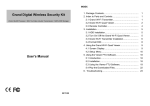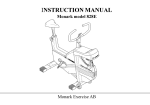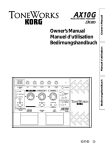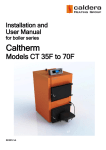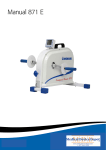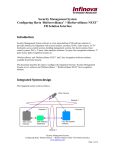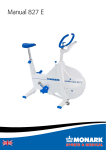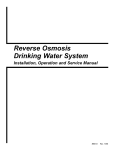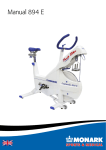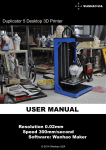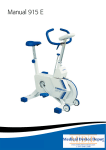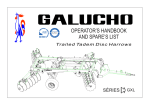Download MANUAL Monark Ergometer 894E
Transcript
MANUAL
Monark Ergometer 894E
CONTENTS
Assembly instructions
Page
5-7
Brake belt/cord replacement
12
Brake belt/cord adjusting
12
Brake surface - flywheel
13
Chain
14
Crank bearing
16
Fitness computer
9
Flywheel bearing
16
General
4
General about exercise
16-17
Operation instruction
8-9
Replacement of batteries
11
Replacement of freewheel sprocket
15
Service checklist
16
Warrenty
4
3
CONGRATULATIONS ON YOUR NEW EXERCISE BIKE
designed by Monark Exercise AB, Sweden. Monark has been the world’s leading manufacturer of
high quality ergometers and exercise cycles for more than 40 years.
GENERAL
It is important that you keep your ergometer clean and properly lubricated. Most important is to
protect the chromed and zinced parts but also painted parts benefit from the same protection.
When cleaning and lubricating be sure to check that all screws and nuts are properly tightened.
Be sure that all moving parts as crank and flywheel is working normal and that no unnormal play
or sound excists. i. e. play in bearings causes fast waring and with that follows a highly reduced
lifetime.
NOTE: The serial number of your test cycle is placed according to fig 1 page 6.
WARRANTY
As on any quality product there may be an exceptional fault due to material or manufacture. If
such a fault should arise on your exercise cycle, please return to the place of purchase for
necessary repair.
Monark products and parts are guaranteed against defects in materials and workmanship for a period of one year from the initial date of purchase of the unit.
Parts found to need replacement due to normal wear and tear, such as brake belts, are not covered.
This guarantee covers parts only, not labor costs associated with the repair.
This guarantee does not apply to cases of abuse or vandalism, nor does it extend to any injury or
loss to person or property caused directly or indirectly by any Monark products.
In the event of a defect in material or workmanship during the warranty period, Monark Exercise
will repair or replace (at its option) the product. Monark Exercise will do so at its expense for the
cost of materials but not for labour or shipping
4
PARTS BELOW ARE NOT ASSEMBLED.
ASSEMBLY INSTRUCTION:
See pages 5-7.
HANDLEBAR/HANDLEBAR STEM
PEDAL, LEFT
PEDAL, RIGHT
SUPPORTING TUBE, FRONT
SUPPORTING TUBE, REAR
WEIGHT HOLDER
5
Tip the cycle forward. Assemble the rear supporting tube with two bolts and two nuts.
NOTE: Use the accompanying spanner.
See fig 1.
Serial number
Fig. 1
Tip the cycle backwards. Assemble the front
supporting tube with two nuts onto the two
fixed bolts.
NOTE: Use the accompanying spanner.
See fig 2.
Fig. 2
Before the handlebar stem is assembled be
sure the expanding wedge is loose. Insert the
handlebar stem into the frame tube and tighten
the expanding bolt firmly by means of the lever.
NOTE: The handlebar stem should be
inserted into the frame tube at least 3
inches (about 8 cm). See fig. 4.
Usually this measure is marked out on the
stem.
8 cm
To change the height of the handlebar, loosen
the expanding bolt about 5 mm. Give the bolt
a light punch to release the expanding wedge.
Adjust the handlebar to the desired position
and tighten the expanding bolt again by means
of the lever.
In order to change the position of the
handlebar, loosen the expanding bolt one turn.
Adjust to desired angle of handlebar and
tighten the expanding bolt/lever firmly again.
6
Fig 4
Check that the inclination of the saddle is
comfortable and that the sadle post bracket
is firmly tightened. In order to change the
inclination of the saddle, loosen the saddle
bracket and tighten firmly again.
Adjust to desired height position of
saddle/saddle post by loosening the saddle
post locking bolt.
NOTE: Tighten firmly. See fig 3.
Post bracket
Saddle post
locking bolt
Fig. 3
Pedal marked R (Right) is to be assembled on
the right hand side of the cycle (the chain
wheel side). The pedal axle has a right hand
thread and must be threaded onto the crank
clockwise. Tighten firmly. See fig 5.
Pedal marked L (Left) is to be assembled on
the left hand side of the cycle. The pedal axle
has a left hand thread and must be threaded
onto the crank counter clockwise. Tighten
firmly. See fig 5.
NOTE! Check now and then that both
pedals are still firmly tightened. If not the
threading in the pedal arms will be
damaged.
Also check that the pedal arms are firmly
tightened on the crank axle. If nessecary
tighten the axle bolt. See fig. 5.
”L” left
Axle bolt
”R” right
Fig. 5
Unscrew the two lower nuts holding the tension
device frame.
Put on the weight holder as in fig. 6.
Screw on and tighten firmly the two nuts again.
Fig. 6
7
OPERATION INSTRUCTION
NOTE! The use of Ergometer 894E can be fysically very strenuous why it is highly
recommended to consult a doctor before use for persons not used to hard exercise and
if you not feel perfectly healthy.
Monark Ergometer model 894E is a test cycle, which have a braking system, of which workload
can be set by weights in a weight basket. Weights are in sizes 1 kg, 0,5 kg and 0,1 kg. This makes
it possible to vary the workload from 1 kg up to maximum 12 kg in steps of 0,1 kg. NOTE: 1 kg
is the lowest work load that can be set as this is the weight of the basket itself. A weight basket
that only weighs 0,5 kg is available as an option.
The weight basket can also be set in its upper free/resting position and does then not give any
work load at all. The weight basket is released by pushing the lock lever, on the left side of the
bike, backwards.
When pedalling the subject stores energy in the flywheel. The flywheel is then braked by means
of a brake belt/cord which runs around the flywheel. The workload is changed either by using
other pedalling speed or by increasing or decreasing the tension of the brake belt/cord against the
flywheel by means of the load tension device.
The height of the saddle should be adjusted so that, when sitting comfortably the middle of the
foot should be above the pedal axle and with the pedal in its lowest position. The knee should
only be slightly bent.
The adjustment of the handlebar should give a comfortable ride. When cycling for a long time, it
may be suitable some time during the exercise to change the position of the handlebar.
Test Computer LED
Fig. 7
8
The ergometer is equipped with a Fitness computer showing pedal revolutions per
minute (RPM), heart rate in bpm (HR), exercise time in minutes and seconds (TIME), cycling
speed in km per hour or miles per hour (SPEED), covered distance in km or mile (DISTANCE).
Furthermore the workload (kp = weight basket + weights in kg) can be set which gives a reading
of burned calories (CAL) as well as power (WATT) on the computer display. The energy is
usually expressed in kJ (kilo Joule) or cal (kilocalorier, kcal). One kcal is aprox.4,2 kJ. The power
is depending on the pedalling speed which makes it possible to adjust the workload/power by
increasing or decreasing the pedalling speed.
Model 894E has also a computer for anaerobic testing and makes the bike possible to connect to
an axternal PC. The PC cable ia included in the bike. A Windows application, included in the
bike, makes it possible to easy make a lot of different type of anaerobic tests for ex. Wingate tests
and so forth. The anaerobic tests can easily be set from 5 up to 300 seconds duartion.
For a closer explanation of the application look in the program manual,
”Monark Anaerobic Test Software User Manual”.
NOTE! To perform anaerobic tests the the computer on the cycle must be connecteed to a mins
supply via a low voltage AC/DC converter. which is included.
Connect the enclosed converter in a suitable mains supply socket.
The circular connector on the secondary cable from the converter is connecteed to the
corresponding socket on the cycle under the instrument cover on the right side. PC cable is
connected into the serial port underneath and to a serial port on an external PC.
Se fig. 11 page 13.
The LED on the front of the instrument panel, se fig. 7 page 8, indicates both that there is power
to the unit and that the weight basket is in its upper locked position. If the weight basket produces
resistance it must be moved upp in its upper locked position where it does not give any workload.
Then the LED is lit - with a delay of about 5 seconds - indicating that the computer and cycle is
in a ready position for a test.
NOTE! At transport the brake cord should be somewhat tightened to prevent it from
falling off the flywheel.
9
FITNESS COMPUTER
SPECIFICATIONS:
RPM:
HR:
TIME:
SPEED:
DISTANCE:
FORCE
CALORIES
WATT
0 - 199
50 - 240
0:00 - 99.59
0 - 99
0.0 - 99.9
0.0 - 7.0
0 - 999
0 - 7 x rpm
Power supply:
Storing temp.:
Operating temp.:
pedalrev./min
bpm
min:sek
km/h or mph
km or mile
kp
kcal
watt
1.5 V x 2
AA(R6)
-10ºC - +60ºC
0ºC - 50ºC
Fig. 8.
Setting KM or MILE
Km and km/h is the dafault setting from the factory.
If you want to make a setting in mile take the meter out of the panel.
Turn off the meter by taking out one battery.
On the back side is a switch with two settings - 1 and ON. See fig. 9.
1 is equal to km and km/h and is the default setting.
ON is equal to mile and mph. Choose position and install the battery again.
Put the meter back again into the panel.
FUNCTION
Press any button or move the pedal to turn on the meter.
At the display for heart rate (HR) a ♥ is lit which means that the meter is trying to find a pulse
signal from an external source (chestbelt with electrodes, our part.no 9339-91).
If the meter can not find such a signal this HR function is automatically turned of after 30
seconds. When the function is turned off the ♥ symbol is not lit any more.
The heart rate function can be turned on again by preessing a button.
Timer starts automatically when pedals are moved. Meter values for Time, Distance and Calories
can be set to zero by pressing the RESET button for more than 2 seconds.
To get correct raedings for calories and watts the kp value on the electronic meter has to be set to
the same value as the workload that is the weight of the basket including the weights in it.
Example: The workload is 3 kg (weight basket 1 kg + 2 x 1kg weight). Press the kp button to the
left on the meter. The lower display window is now flashing and showing figures in kp. Increase
or decrease in steps of 0.1 kp by pressing the kp button(!) or the RESET button(") until the
reading is corresponding with the actual or desired kp values (workload) from the weight basket.
After that press the CAL/WATT button to either show the CAL or WATT figures.
The watt reading in the display is depending on the pedalling speed. The watts can accordingly be
adjusted by increasing or decreasing the pedalling speed.
Calories are calculated all the time.
Do not expose the fitness computer to direct sunlight or extremely high temperature. Do not use
any dissolvents when cleaning. Use only dry cloth.
10
REPLACEMENT OF BATTERIES
NOTE: The batteries are at delivery in a separat package.
If the batteries have been stored for a long time, the battery power can be too low to show all
functions on the meter. If so, batteries must be replaced.
The battery package can be reached from the down side of the panel.
Be careful to put in the new batteries with + and - correctly positioned. See fig. 9.
If needed the complete fitness computer can be taken out from the panel by loosing the upper
fastening plate on the down side of the meter/panel. Lift in the upper end of the meter and take it
out from the panel.
The batteries, 2 x 1.5V size AA(R6), which are placed in the holder on the backside of the meter,
can then easily be changed. See fig.8.
After the batteries has been replaced all segments in the display are visible and a buzzer will
sound for two seconds. After 2 seconds the meter turns to main display again and normal
function.
Put the meter into the housing again.
km - mile
Fig. 9
11
BRAKE CORD/BELT
REPLACEMENT
Remove the instrument cover by loosen the screws
on each side of the cover.
Take the return strap, see fig. 11, and lift up the
weight basket until it locks in its upper position.
Loosen the cord/belt bracket, see fig. 11, and take
away the brake belt from the tension center.
Loosen or cut away the knot or tie up the knot at
the other end of the belt. After that take away the
belt from the bike.
When assembling a new brake cord/belt, first
enter one end into the belt whole in the tension
center, see fig. 11, and make a knot and let the
knot fall into the bigger part of the hole.
Then assemble the new belt exactly as the old one.
See fig. 10.
NOTE! When replacing the brake cord/belt it
is recommended to clean the brake surface.
See next page
BRAKE SURFACE - BRAKE BELT.
Fig. 10
ADJUSTING THE BRAKE CORD/BELT TENSION
At first check that the brake belt is lying correct on the flywheel brake surface.
See fig. 10.
Put 4 kg in the weight basket. Rotate the flywheel by hand. The basket shall now lift up so the
distance to the flywheel is at least 40 mm. and maximum 80 mm. If this is not the case the brake
belt has to be loosened or tightened a little at the tension center. If the basket is too low shorten
the belt somewhat and if the basket is too high lenghten the cord somewhat.
Lock the weight basket in its upper position and after that loosen the cord bracket somewhat so
that the cord length can be adjusted. Tighten the braket again and release and check if the
measurements above are OK when the flywheel is rotated by hand.
Repeat the above if necessary.
Note: The basket will always give the correct workload wherever it hangs between the upper stop
position and the lower stop just above the flywheel. The measurements above just gives a good
margin - about 30 mm in each direction.
12
Stop lever
Stop
DC connector
Cord bracket
Tension center
Return strap
PC serial port
Hole fore cord knot
Fig.11
FLYWHEEL BRAKE SURFACE - BRAKE BELT
The brake cord should be regularly checked to
ensure that it has not suffered execessive wear. If it
looks worn it should be replaced.
Deposits of dirt on the brake cord and irregularities
on the brake surface may cause the unit to operate
unevenly and will also wear down the brake cord
faster and the unit can become noisy. The brake surface of the flywheel should then be ground off with
a fine sand paper and any dust removed with a clean
dry cloth.
Lift the weight basket to its upper locked position.
Grind with a fine sand paper. See fig. 12.
Grinding is easier to perform if a second individual
cautiously and slowly pedals the cycle.
NOTE: Always keep the brake belt contact surface
clean and dry. No lubricant is allowed to be used.
We recommend to replace the brake belt when
cleaning the contact surface.
As regards assembly and adjustment of the brake
belt, see previous page.
Brake surface
Sand paper
Fig.12
13
CHAIN ½ x 1/8“
It is strongly recommended that a cahin solvent be used to keep the chain clean. Excess dirt built
up on the chain will cause excess wear. A chain lubricant and solvent for normal road bikes may
be uaed.
Check the lubrication and tension of the chain at regular intervals. In the middle of its free length
the chain should have a minimum play of 5 mm. See fig 13. When the play in the chain is about
20 mm (<1 inch) the chain must be tightened otherwise it will cause unnormal wear of the chin
and chainwheels. Because of this it is always recommende to keep the chain play as little as
possible. When the chain has become so long that it can no longer be tightened with the chain
adjusters it is worn out and shall be replaced with a new one.
ADJUSTING CHAIN
Remove left and right frame cover.
To adjust the chain the hub nuts should be loosened. Loosening or tightening the nuts on the chain
adjusters will then move the hub and axle forward or backward. Adjust according to above
recommendation. Then tighten the nuts on the hub axle again. See fig 13.
CHAIN REPLACEMENT
Loosen the chain adjusteras much as possible. Dismantle the cahinlock and remove the chain. Put
on a new chain and assemble the chain lock.The spring of the chain lock should be assembled
with the closed end in the movement direction of the chain. Use a pair of tongs for dismantling
and assembling the spring. See fig 14.
Adjust chain adjusters to chainplay according to above. Tighten axle nuts firmly.
Put on frame covers again.
NOTE: At assembly the flywheel has to be parallell with the center line of the frame
otherwise the chain and chainwheels makes a lot of noise and wears out very rapidly.
Chain adjuster
Lock spring
Axle nut
Chain lock
Chin play
Fig. 13
14
Fig. 14
REPLACEMENT OF THE FREEWHEELING SPROCKET
Remove left and right frame cover.
Dismantle the chain as described on page 20 - 21.
Loosen the axle nuts and lift off the flywheel. Remove the axle nut, washer, chain
adjuster and spacer on the freewheel side. Place the special remover (part No. 9100-14)
in the adapter and place the spacer and axle nut outside. See fig 15.
NOTE: Do not tighten the axle nut completely. It must be possible to loosen the adaptersprocket half a turn.
Replace sprocket-adapter and assemble the new parts in reverse order according to the
above.
LUBRICATION SPROCKET
The sprocket should be lubricated with a few drops of oil once a year. Incline the cycle
somewhat to make it easier for the oil to reach the bearing. See fig 16.
Fig. 15
Fig. 16
15
CRANK BEARING
The crank bearing is long term greased and needs normally no supplementary lubrication. If problem arises, please contact your Monark dealer.
FLYWHEEL BEARING
The bearings in the flywheel are lifetime greased and require normally no maintenance. If problem arises, please contact your Monark dealer.
SERVICE CHECKLIST
Check the:
! chain is snug and there is no play on the pedal crank
! pedal crank is secure to the crank axle
! pedals moving smoothly, and is the pedal axle clear of dirt and fibres
! pedals are securely fitted to the pedal crank
! handlebar not higher than min required insertion length
! flywheel rotating smoothly and central
! handlebars and saddle adjustment screws lubricated
! pressure washer on saddle tube is present
! saddle clip is tight and that the saddle is at a correct angle.
! brake belt does not show significant signs of wear
! pedals and chain are lubricated
THE IMPORTANCE OF REGULAR EXERCISE
The human body is built for action – not for rest. Once upon a time this was a necessity: the
struggle for survival demanded good physical condition. But optimal function can only be
achieved by regularly exposing the heart, circulation, muscles, tendons, skeleton and nervous system to some loading, i.e. training.
In the old days the body got its exercise both in work and at leisure. In our modern society,
however, machines have taken over an ever increasing share of the tasks which were formerly
accomplished with muscular power alone. Our life has at an accelerated tempo been dominated
by sitting, riding and lying. Thus, the natural and vital stimulation that tissues and internal organs
receive through physical exercise has largely disappeared. Certain tissues such as muscles, bone
and blood and also a number of bodily functions can adapt to inactivity – and to stress. Studies
have proved that if you use 30 minutes for exercise like brisk walking, running, bicycling,
swimming or skiing 2-3 times a week, your condition has been improved by some 15 per cent
after a few months. The efficiency of the heart muscle will increase and joints and muscles grow
in strength. The capillary density increases in the trained muscle and their enzymatic activities are
enhanced. The body adapts to the new demands. The perceived exertion at a given rate of exercise
becomes reduced.
With increased physical activity fatness is concentrated, the appetite functions “safer”, you can
eat more without risk for overweight and thereby the risk of lack of important essential food
nutrients decreases. For many individuals the effect of habitual physical activity also improves the
wellbeing and it is a good feeling to have a potential to cope with straining situations.
16
WHAT KIND OF EXERCISE TO CHOOSE?
1. You should have fun when exercising. Choose something you find pleasure in doing regularly.
2. To get o good effect out of the training you should choose a form of exercise that engages
large muscle groups. Then the demand of increased blood flow and oxygen transport will be
so great that heart will increase its pump capacity. Jogging, calesthenics, aerobic dancing,
bicycling, swimming, skiing and walking are excellent examples of exercises meeting this
requirement.
IN A FEW MONTHS YOU CAN GET 10-15 YEARS YOUNGER
If you cycle 30 minutes a few times a week you can lower your condition age with 10-15 years!
Scientifically this is described as a reduction on the biological age. Externally, you are your usual
self. Internally, however, you feel much younger. In other words: You can work harder. You feel
more alert and healthy. Your ability to handle stress and problems increases. There are few better
ways to improve your physical condition than to cycle. It does not over-tax your joints. It builds
up your condition progressively and at your own pace – and you can make your training fit
weather conditions.
DO I LOOSE WEIGHT WHEN I CYCLING?
Yes! You do lose calories. A few miles on your bike every day over one year, you will have lost
the equivalent of 20 pounds of body fat. You will achieve best results if you combine exercise
with healthier eating. A little less sugar, less butter on your bread or less fat in your frying pan.
And a few miles on your bike every day. In a year you will have lost 20 pounds.
DO I GET STRONGER?
Cycling strengthens the muscles of the back, abdomen and legs. Daily chores become easier.
Cycling also makes your heart stronger. Your pulse rate gets lower even when you exert yourself a
little extra. Regular exercise also has a favourable influence on high blood pressures.
HOW DO I TRAIN?
1. Warm up 3-5 minutes with a low pedal resistance. Pedal about 12 mph (20 km/h).
2. Increase the resistance until you feel the training “somewhat hard”. Keep the speed for 2-5
minutes. Get off the Ergometer and rest a few minutes. Cycle again and then rest. Train at
your own pace and with a comfortable pedal resistance. After a few weeks you can increase
the resistance.
3. Before ending, pedal a few minutes with a light resistance, in order to step down your
training.
Total time about 30 minutes.
Strength training:
1. Give yourself a thorough warm-up.
2. Pedal with a heavy resistance for 5-10 seconds, then rest 45-60 seconds. Repeat this 5-10
times.
It is a good idea to combine your cycle training with gymnastics for 5 minutes, as this will give
you a physiologically well-balanced form of training.
(Elderly people and physically weak persons should consult a doctor before starting their
training.)
17
78050 Vansbro, 432 82 Varberg
Tel: +46 0281 594940
Fax:+46 0340 80485


















